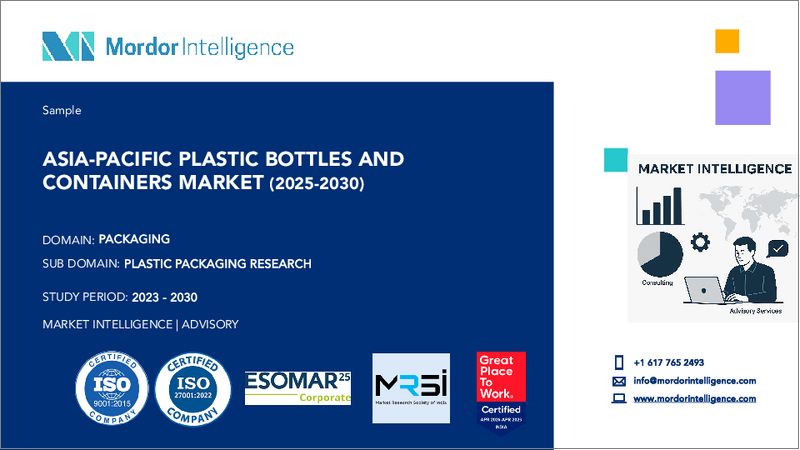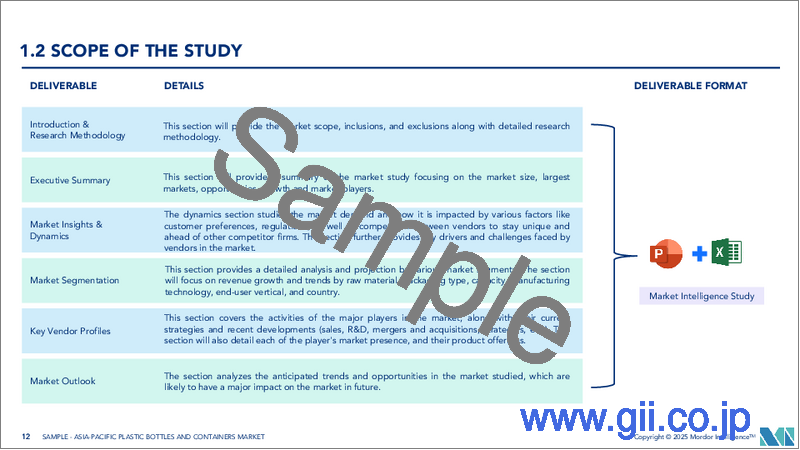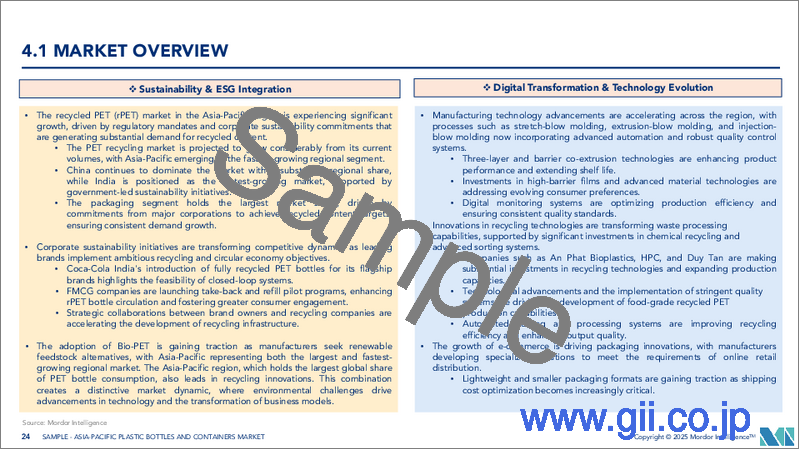|
|
市場調査レポート
商品コード
1683108
アジア太平洋地域のプラスチックボトルおよび容器:市場シェア分析、産業動向と統計、成長予測(2025年~2030年)Asia-Pacific Plastic Bottles And Containers - Market Share Analysis, Industry Trends & Statistics, Growth Forecasts (2025 - 2030) |
||||||
カスタマイズ可能
適宜更新あり
|
|||||||
| アジア太平洋地域のプラスチックボトルおよび容器:市場シェア分析、産業動向と統計、成長予測(2025年~2030年) |
|
出版日: 2025年03月18日
発行: Mordor Intelligence
ページ情報: 英文 140 Pages
納期: 2~3営業日
|
全表示
- 概要
- 目次
アジア太平洋地域のプラスチックボトルおよび容器の市場規模は、2025年に295億6,000万米ドルと推定され、予測期間(2025-2030年)のCAGRは4.52%で、2030年には368億7,000万米ドルに達すると予測されます。
生産量では、市場は2025年の2,050万トンから2030年には2,563万トンに、予測期間(2025-2030年)のCAGRは4.57%で成長すると予測されます。

主なハイライト
- プラスチック素材は軽量で割れにくく、マテリアルハンドリングが容易なため、プラスチック包装は他の製品よりも消費者の間で人気があります。大手メーカーでさえ、生産コストの低さからプラスチック包装の使用を好んでいます。さらに、ポリエチレンテレフタレート(PET)や高密度ポリエチレン(HDPE)などのポリマーの導入により、ペットボトルの用途が拡大しています。市場ではPETボトルの需要が増加しています。
- ポリエチレンテレフタレート、ポリプロピレン、ポリエチレン製のプラスチックボトルや容器は、軽量でリサイクルしやすい素材であるため広く使用されており、エンドユーザーの間で好まれています。プラスチック素材の費用対効果の高さと、包装された加工食品や各種飲食品への依存は、予測期間中の調査市場に影響を与えると思われます。
- 軽量プラスチック包装は、包装された商品を輸送する際のエネルギーを節約し、排出量を減らすことができるため、プラスチックはその軽量特性のためにますます採用されています。プラスチックの軽量特性は市場拡大の主な利点です。プラスチックよりはるかに重いガラスのような他の材料と比較すると、輸送中に多くの移動が必要になります。
- 市場の成長は、この地域の多様な産業で応用範囲が広がっていることにも起因しています。例えば、製薬業界では、プラスチックボトルは、製品の安定性を維持する耐湿性があるため、錠剤、シロップ、カプセルの信頼できる包装オプションとなります。パーソナルケアや化粧品業界では、プラスチックボトルは耐久性と見た目の美しさから、シャンプー、コンディショナー、ローション、クリームの包装に理想的な選択肢です。
- しかし、プラスチック汚染への懸念が高まるにつれ、製造業者や消費者は環境に優しい特性を持つ他の包装材料にも目を向けるようになっています。アルミニウムやガラスの消費は、リサイクル性の高さから採用率が上昇する可能性があります。このことは、この市場の成長を妨げると予想されます。
- とはいえ、アジア太平洋地域は改善されたより良い経済成長とダイナミックな人口動態の変化を経験しており、この地域の開発に大きな影響を与えています。スーパーマーケットやハイパーマーケットを含む組織小売の成長は、包装商品の需要を高めています。これらの店舗では、消費者の多様なニーズに応えるために大規模な包装が必要とされ、市場全体を牽引しています。
アジア太平洋地域のプラスチックボトルおよび容器の市場動向
ポリエチレンテレフタレート(PET)セグメントが主要市場シェアを占める
- PET製のプラスチックボトルは、ミネラルウォーターやその他の飲料用に再利用可能な包装を提供し、より経済的な輸送プロセスを可能にするため、重くて壊れやすいガラスボトルに代わって広く普及しています。
- PETは透明度が高く、天然のCO2バリア特性を持つため、用途が広く、ボトルへの吹き込みやその他の形状への成形が容易です。PETの特性は、着色剤、UVカット剤、酸素バリアー/スカベンジャー、その他の添加剤で改善することができ、ブランドの特定のニーズに合ったボトルを開発することができます。
- PETは、この地域のボトルメーカーの間で重要な包装材料の一つとなっています。様々な形状やサイズに対応できるPETの汎用性は、従来のガラスや金属容器に代わる比類のない選択肢を提供し、包装業界において非常に望ましい選択肢となっています。
- ポリエチレンテレフタレート(PET)ボトルは様々な製品分野で存在感を増しています。低価格、軽量、印刷技術の開発により、PETボトルは高級志向の消費者の間で人気を博しています。
- 持続可能な化学企業Indorama Venturesの報告書によると、アジアにおける再生ポリエチレンテレフタレート(RPET)の需要は、2018年の60万トンから2023年には約100万トンに絶えず増加すると予想されています。
- さらに2023年9月、インドラマ・ベンチャーズ公開会社(Indorama Ventures Public Company Limited)は、消費者使用後のPETボトルを1,000億本リサイクルしたと発表しました。これにより、210万トンの廃棄物が転用され、290万トンの二酸化炭素排出量が削減され、PETの循環型経済の確立に貢献しました。インドラマ・ベンチャーズは、使用済みPETボトルの廃棄物回収に10億米ドル以上を費やしました。
- PETリサイクルの将来は、このプロセスをより効率的で費用対効果に優れ、環境にも優しいものにする技術の進歩に密接に関係しています。使用済みPET製品を回収し、加工し、新しい包装材料に変える能力は、バージン資源への依存を減らし、環境廃棄物を軽減する絶大な機会を提供します。
中国が大きな市場シェアを占めると予想される
- 中国は、世界的に見てもプラスチックの主要な生産国と消費国の一つです。OECDによると、中国のプラスチック使用量は今後40年間で大幅に増加し、2060年には2億312万トン以上に達すると予測されています。PET(ポリエチレンテレフタレート)、HDPE(高密度ポリエチレン)、その他のポリマーを使用したペットボトルや容器が、飲食品、医薬品、パーソナルケア産業への依存度を高めていることから、中国からのプラスチックの生産と輸出に注目が集まっています。
- 国際貿易センター(ITC)のデータによると、中国のプラスチック製品の最大の輸出先は米国です。中国は2023年に2億9,260万トンのプラスチック製品を米国に輸出し、前年比8.00%増となりました。プラスチック貿易の潜在的成長機会が高いことから、今後数年間は同国のプラスチック需要が増加すると予想されます。
- 中国は、再生プラスチックを推進するため、持続可能で環境に優しい慣行への転換を目の当たりにしています。その結果、コカ・コーラのような飲料メーカーは、環境フットプリントを削減する戦略の一環として再生プラスチックを使用するようになりました。
- 2024年4月、米国の飲料会社コカ・コーラ社は、再生ポリエチレンテレフタレート(rPET)製のコカ・コーラ・オリジナル、コカ・コーラ無糖、コカ・コーラ・プラスのボトルを香港で発売しました。
- 中国は、「不合理な」プラスチック包装を削減し、都市部でのゴミ焼却率を現在の58万トン/日から2025年までに約80万トン/日に引き上げるよう、商店や配送業者に促しています。こうした開発により、同国のリサイクル可能なプラスチック包装の需要が増加すると予想されます。
アジア太平洋地域のプラスチックボトルおよび容器産業の概要
アジア太平洋地域のプラスチックボトルおよび容器市場は、Gerresheimer AG、Pact Group Holdings Limited、Alpla Group、Berry Global Inc.、Alpha Packaging Pvt.Ltd.などの大手企業が存在し、断片化されています。市場のプレーヤーは、製品ラインナップを強化し、持続可能な競争優位性を獲得するために、提携や買収などの戦略を採用しています。
- 2023年10月-Manjushree Technopack社は、Ganesha Ecosphere Groupのボトルからボトルへのグレードのリサイクル部門と、再生プラスチックを使用した食品・非食品グレードの包装製品を共同開発・供給するための提携契約を締結しました。このパートナーシップは、29年度までにバージンプラスチックの最大60%を再生プラスチックに置き換えるというインド政府の野心的な目標を支援しながら、新しい(プラスチック廃棄物管理)PWM規則を遵守する上で各ブランドに貢献することを目的としています。また、このパートナーシップは、循環型経済の構築を支援し、100%リサイクルペットボトルの採用を加速させることも目的としています。
- 2023年12月-オーストラリアのパクト・グループは、クリーンウェイ廃棄物管理、アサヒ飲料、ココ・コーラ・ユーロパシフィック・パートナーズと共同で、メルボルンにPETボトルリサイクル工場を開設。サーキュラー・プラスチックス・オーストラリア(PET)工場は、使用済みペットボトルを高品質の食品用樹脂に変換し、新しいリサイクルPET飲料ボトルやその他のパッケージ製品の製造に使用します。同工場は、1時間当たり2.5トン、年間2万トンのrPET樹脂を生産できる設備を備えています。
その他の特典
- エクセル形式の市場予測(ME)シート
- 3ヶ月間のアナリスト・サポート
目次
第1章 イントロダクション
- 調査の前提条件と市場定義
- 調査範囲
第2章 調査手法
第3章 エグゼクティブサマリー
第4章 市場洞察
- 市場概要
- 産業バリューチェーン分析
- 業界の魅力度-ポーターのファイブフォース分析
- 供給企業の交渉力
- 買い手の交渉力
- 新規参入業者の脅威
- 競争企業間の敵対関係
- 代替品の脅威
第5章 市場力学
- 市場促進要因
- 軽量包装方式の採用増加
- 人口動態とライフスタイルの変化
- 市場抑制要因
- プラスチック使用に対する環境問題の高まり
第6章 市場セグメンテーション
- 原材料別
- ポリエチレンテレフタレート(PET)
- ポリプロピレン(PP)
- 低密度ポリエチレン(LDPE)
- 高密度ポリエチレン(HDPE)
- その他の原材料
- エンドユーザー業界別
- 飲料
- ボトル入り飲料水
- 炭酸飲料
- 乳飲料
- その他の飲料
- 食品
- 化粧品
- 医薬品
- 家庭用品
- その他業界別
- 飲料
- 国別
- 中国
- インド
- 日本
- オーストラリア・ニュージーランド
- 東南アジア
第7章 競合情勢
- 企業プロファイル
- Gerresheimer AG
- Pact Group Holdings Limited
- Alpla Group
- Berry Global Inc.
- Alpha Packaging Pvt. Ltd
- Mauser Packaging Solutions(Bway Holding Corporation)
- Greiner Packaging International GmbH
- Retal Industries Limited
- Zhejiang Xinlei Packaging Co. Ltd
- Shenzhen Zhenghao Plastic & Mold Co. Ltd
- Manjushree Technopack Limited
第8章 投資分析
第9章 市場の将来
The Asia-Pacific Plastic Bottles And Containers Market size is estimated at USD 29.56 billion in 2025, and is expected to reach USD 36.87 billion by 2030, at a CAGR of 4.52% during the forecast period (2025-2030). In terms of production volume, the market is expected to grow from 20.50 million metric tons in 2025 to 25.63 million metric tons by 2030, at a CAGR of 4.57% during the forecast period (2025-2030).

Key Highlights
- Plastic packaging has become popular among consumers over other products, as plastic material is lightweight and unbreakable, making it easier to handle. Even major manufacturers prefer to use plastic packaging, owing to the lower cost of production. Moreover, the introduction of polymers, such as polyethylene terephthalate (PET) and high-density polyethylene (HDPE), is expanding the applications of plastic bottles. The market has been witnessing an increasing demand for PET bottles.
- Plastic bottles and containers made of polyethylene terephthalate, polypropylene, and polyethylene are widely used as the material is lightweight and easily recyclable, making it the preferred choice among the end-users. The cost-effective nature of plastic material and dependence on packaged, processed food and various beverages will influence the studied market over the forecast period.
- Plastics have been increasingly adopted due to their lightweight properties because lightweight plastic packaging can preserve energy in transporting packed goods and lower emissions. The lightweight properties of plastic are the primary advantage of expanding the market. Compared to other materials, such as glass, which is much heavier than plastic, more trips are required while transporting.
- The market's growth can also be attributed to the expanding range of applications across diverse industries in the region. For instance, within the pharmaceutical industry, plastic bottles offer a reliable packaging option for tablets, syrups, and capsules due to their moisture-resistant properties that maintain product stability. In personal care and cosmetics, plastic bottles are an ideal option for packaging shampoos, conditioners, lotions, and creams, owing to their durability and visual appeal.
- However, with growing concerns about plastic pollution, manufacturers and consumers are also inclining themselves toward other packaging materials that offer environment-friendly properties. The consumption of aluminum and glass might witness rising adoption rates owing to their high recyclability. This is expected to hinder the growth of the market studied.
- Nevertheless, the Asia-Pacific region has experienced improved and better economic growth and dynamic demographic changes that have significantly influenced the region's development. The growth of organized retail, including supermarkets and hypermarkets, has heightened the demand for packaged goods. These outlets require extensive packaging to cater to the diverse needs of consumers, driving the overall market.
Asia-Pacific Plastic Bottles And Containers Market Trends
Polyethylene Terephthalate (PET) Segment Holds Major Market Share
- Plastic bottles made from PET are widely replacing heavy and fragile glass bottles since they offer reusable packaging for mineral water and other beverages, allowing a more economical transportation process.
- With its clarity and natural CO2 barrier properties, PET has wide applications and is easily blown into a bottle or molded into any other shape. PET properties can be improved with colorants, UV blockers, oxygen barriers/scavengers, and other additives to develop a bottle to match a brand's specific needs.
- PET has become one of the vital packaging materials among bottle manufacturers across the region. PET's versatility in accommodating different shapes and sizes has provided unparalleled alternatives to conventional glass and metal containers, making it a highly desirable choice in the packaging industry.
- Polyethylene terephthalate (PET) bottles are gaining a presence in various product areas. Low cost, low weight, and ongoing developments in printing technology have led to PET bottles gaining popularity among premium consumers.
- As per the report of Indorama Ventures, a sustainable chemical company, the demand for recycled polyethylene terephthalate (RPET) in Asia is expected to increase constantly from 0.6 million metric tons in 2018 to approximately 1 million metric tons in 2023.
- Further, in September 2023, Indorama Ventures Public Company Limited notified that it had recycled 100 billion post-consumer PET bottles. This has diverted 2.1 million tons of waste, preserved 2.9 million tons of carbon footprint, and helped in establishing a circular economy for PET. Indorama Ventures spent more than USD 1 billion on the waste collection of used PET bottles.
- The future of PET recycling closely revolves around technological advancements that make the process more efficient, cost-effective, as well as environmentally friendly. The ability to collect, process, and transform used PET products into new packaging materials provides an immense opportunity to reduce dependency on virgin resources, therefore mitigating environmental waste.
China Expected to Hold Significant Market Share
- China is one of the major producers and consumers of plastic globally. According to the OECD, China's plastics use is projected to grow considerably over the next four decades, reaching more than 203.12 million metric tons by 2060. The growing dependence on plastic bottles and containers made using PET (Polyethylene Terephthalate), HDPE (High-Density Polyethylene), and other polymers for food & beverage, pharmaceutical, and personal care industries has increased the focus on the production and export of plastics from China.
- According to data from the International Trade Center (ITC), China's largest export of plastic products is to the United States of America. China exported 292.6 million tons of plastic products to the USA in 2023, which was 8.00% higher than the previous year. The high potential growth opportunity in plastic trade is expected to increase the country's demand for plastic in the coming years.
- China is witnessing a shift in its focus on sustainable and eco-friendly practices to promote recycled plastic. This has resulted in beverage manufacturers such as Coca-Cola using recycled plastic as part of their strategy to reduce their environmental footprint.
- In April 2024, Coca-Cola Company, a United States-based beverage company, launched Coca-Cola Original, Coca-Cola No Sugar, and Coca-Cola Plus bottles made from recycled polyethylene terephthalate (rPET) in Hong Kong.
- China has been prompting merchants and delivery companies to reduce "unreasonable" plastic wrapping and increase garbage incineration rates in cities to about 800,000 tons per day by 2025, up from 580,000 tons currently. Such developments are expected to increase the country's recyclable plastic packaging demand.
Asia-Pacific Plastic Bottles And Containers Industry Overview
The Asia Pacific Plastic Bottles and Containers market is fragmented with the presence of major players like Gerresheimer AG, Pact Group Holdings Limited, Alpla Group, Berry Global Inc., and Alpha Packaging Pvt. Ltd. Players in the market are adopting strategies such as partnerships and acquisitions to enhance their product offerings and gain sustainable competitive advantage.
- October 2023 - Manjushree Technopack entered into a collaboration agreement with the bottle-to-bottle grade recycling division of Ganesha Ecosphere Group to co-develop and supply food and non-food grade packaging products made of recycled plastics. The partnership sets to serve the brands in complying with the new (Plastic Waste Management) PWM rules while supporting the Indian government's ambitious target of replacing up to 60% of virgin plastic with recycled plastic by FY29. The partnership also aims to help create a circular economy and accelerate the adoption of 100% recycled plastic bottles.
- December 2023 - Pact Group, an Australia-based company, in partnership with Cleanway Waste Management, Asahi Beverages, and Coco-Cola Europacific Partners, opened a PET bottle recycling plant in Melbourne. The Circular Plastics Australia (PET) plant will convert used plastic bottles into high-quality food-grade resin, which will be used to make new recycled PET beverage bottles and other packaging products. The facility is equipped to produce 2.5 tons of rPET resin per hour and 20,000 tons of rPET resin each year.
Additional Benefits:
- The market estimate (ME) sheet in Excel format
- 3 months of analyst support
TABLE OF CONTENTS
1 INTRODUCTION
- 1.1 Study Assumptions and Market Definition
- 1.2 Scope of the Study
2 RESEARCH METHODOLOGY
3 EXECUTIVE SUMMARY
4 MARKET INSIGHTS
- 4.1 Market Overview
- 4.2 Industry Value Chain Analysis
- 4.3 Industry Attractiveness - Porter's Five Forces Analysis
- 4.3.1 Bargaining Power of Suppliers
- 4.3.2 Bargaining Power of Buyers
- 4.3.3 Threat of New Entrants
- 4.3.4 Intensity of Competitive Rivalry
- 4.3.5 Threat of Substitute Products
5 MARKET DYNAMICS
- 5.1 Market Drivers
- 5.1.1 Increasing Adoption of Lightweight Packaging Methods
- 5.1.2 Changing Demographic and Lifestyle Factors
- 5.2 Market Restraints
- 5.2.1 Growing Environmental Concerns Over the Use of Plastics
6 MARKET SEGMENTATION
- 6.1 By Raw Materials
- 6.1.1 Polyethylene Terephthalate (PET)
- 6.1.2 Polypropylene (PP)
- 6.1.3 Low-Density Polyethylene (LDPE)
- 6.1.4 High-Density Polyethylene (HDPE)
- 6.1.5 Other Raw Materials
- 6.2 By End-user Vertical
- 6.2.1 Beverages
- 6.2.1.1 Bottled Water
- 6.2.1.2 Carbonated Soft Drinks
- 6.2.1.3 Dairy-based
- 6.2.1.4 Other Beverages
- 6.2.2 Food
- 6.2.3 Cosmetics
- 6.2.4 Pharmaceuticals
- 6.2.5 Household Care
- 6.2.6 Other End-user Verticals
- 6.2.1 Beverages
- 6.3 By Country
- 6.3.1 China
- 6.3.2 India
- 6.3.3 Japan
- 6.3.4 Australia and New Zealand
- 6.3.5 South East Asia
7 COMPETITIVE LANDSCAPE
- 7.1 Company Profiles
- 7.1.1 Gerresheimer AG
- 7.1.2 Pact Group Holdings Limited
- 7.1.3 Alpla Group
- 7.1.4 Berry Global Inc.
- 7.1.5 Alpha Packaging Pvt. Ltd
- 7.1.6 Mauser Packaging Solutions (Bway Holding Corporation)
- 7.1.7 Greiner Packaging International GmbH
- 7.1.8 Retal Industries Limited
- 7.1.9 Zhejiang Xinlei Packaging Co. Ltd
- 7.1.10 Shenzhen Zhenghao Plastic & Mold Co. Ltd
- 7.1.11 Manjushree Technopack Limited






